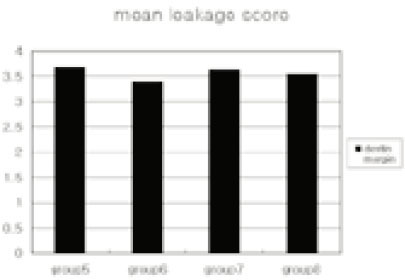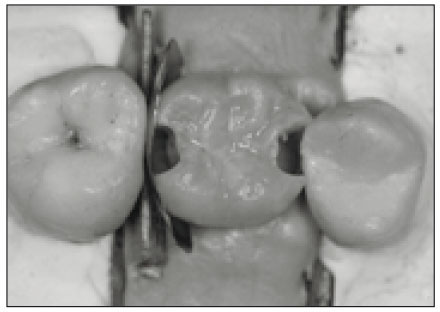Articles
- Page Path
- HOME > Restor Dent Endod > Volume 27(3); 2002 > Article
- Original Article Microleakage of posterior packable composite resin at the gingival margins of class II cavities
- Su-Jin Choi, D.D.S., Mi-Ja Kim, D.D.S., M.S.D., Ph.D., Hyuk-Choon Kwon, D.D.S., M.S.D.
-
2002;27(3):-256.
DOI: https://doi.org/10.5395/JKACD.2002.27.3.249
Published online: May 31, 2002
Department of Conservative Dentistry, College of Dentistry, Seoul National University, Korea.
Copyright © 2002 Korean Academy of Conservative Dentistry
- 840 Views
- 2 Download
- 1 Crossref
Abstract
-
The use of flowable composite resins as liners in class II packable composite restoration has been suggested by some manufacturers. However, the contributions of this technique are unproven. The purpose of this study was to compare the gingival microleakage in class II packable composite restorations with or without the use of flowable composite resins as liners.Slot cavities were prepared on both proximals of 80 extracted human molars and randomly assigned to 8 groups of 20 each. The gingival margins were located at 1mm above CEJ in 80 cavities (group1-4) and 1mm below CEJ in 80 cavities (group5-8). The prepared teeth were mounted in the customized tray with adjacent teeth to simulate clinical conditions and metallic matrix band (Sectional matrix) and wooden wedges were applied. After acid etching and application of Single Bond, each group was restored with the following materials using incremental placement technique: Group 1,5 (Filtek P60), group 2, 3, 4 and group 6, 7, 8 (AeliteFlo, TetricFlow, Revolution/Filtek P60). All specimens were thermocycled 500 times between 5℃ and 55℃ with 1 mimute dwell time, immersed 2% methylene blue dye for 24 hours and then rinsed with tab water. The specimens were embedded in clear resin and sectioned longitudinally through the center of restoration with a low speed diamond saw. Dye penetration at gingival margin was viewed at 20 magnification and analyzed on a scale of 0 to 4. Kruscal-Wallis One way analysis and Mann-Whitney Rank sum test were used to analyze the results.The results of this study were as follows.1. The leakage values seen at the enamel margin were significantly lower than those seen at the dentin margin(P<0.05).2. On the enamel margin, packable composite resins with flowable liners showed lower leakage than those without flowable liners, but there were no significant differences among the four groups(P>0.05).3. On the dentin margin, four groups demonstrated moderate to severe leakage, and there were no significant differences in leakage values(P>0.05).
- 1. Phillips RW, Avery DR, Mehra R, Swartx ML, Mccune RJ. Observations on a composite resin for Class II restorations: Three-year report. J Prosthet Dent. 1973;30(6):891-897.ArticlePubMed
- 2. Belvedere P. Posterior composites experiencing growth trend. Dent Today. 1999;18(3):44. 46-47.
- 3. Leinfelder KF, Radz GM, Nash RW. A report on a new condensable composite resin. Compend Contin Educ Dent. 1998;19(3):230-237.PubMed
- 4. Alster D, Feilzer AJ, De Gee AJ, Mol A, Davidson CL. The dependence of shrinkage stress reduction on porosity concentration in thin resin layers. J Dent Res. 1992;71: 1619-1621.ArticlePubMedPDF
- 5. Ehrnflrd L, Derand T. Cervical gap formation in class II composite resin restoration. Swed Dent J. 1984;8: 15-19.PubMed
- 6. Qvist V. Resin resorations: Leakage, bacteria, pulp. Endod Dent Traumatol. 1993;9: 127-152.PubMed
- 7. Tjan AH, Bergh BH, Lindner C. Effect of various incremental techniques on the marginal adaptation of class II composite resin restorations. J Prosthet Dent. 1992;67: 62-66.ArticlePubMed
- 8. Lutz E, Krejci I, Oldenburg TR. Elimination of polymerization stresses at the margin of posterior composite resin restorations: a new restorative technique. Quintessence Int. 1986;17: 777-784.PubMed
- 9. Fusayama T. Indications for self-cured and light cured adhesive composite resins. J Prosthet Dent. 1992;67: 46-51.ArticlePubMed
- 10. Crim GA, Champman KW. Reducing microleakage in class II restorations: an in vitro study. Quintessence Int. 1994;25: 781-785.PubMed
- 11. Aboushala A, Kugel G, Hurley E. Class II composite resin restorations using glass-ionomer liners: microleakage studies. J Clin Pediatr Dent. 1996;21: 67-70.PubMed
- 12. Bayne SC, Thompson JY, Swift EJ Jr, Stamatiades P, Wilkersin M. A characterization of first-generation flowable composites. J Am Dent Assoc. 1998;129: 567-577.ArticlePubMed
- 13. Leinfelder K. New developments in composite resins. Interview by Phillip Bonner. Dent Today. 1997;16(4):44. 46-47.
- 14. Leevailoj C, Cochran MA, Matis BA, Moore BK, Platt JA. Microleakage of posterior packable resin composites with and without flowable liners. Oper Dent. 2001;26(3):302-307.PubMed
- 15. Chuang SF, Liu JK, Chao CC, Liao FP, Chen YH. Effects of flowable composite lining and operator experience on microleakage and internal voids in class II composite resorations. J Prosthet Dent. 2001;85(2):177-183.PubMed
- 16. Belli S, Inokoshi S, Ozer F, Pereira PN, Ogata M, Tagami J. The effect of additional enamel etching and a flowable composite to the interfacial integrity of class II adhesive composite restoration. Oper Dent. 2001;26(1):70-75.PubMed
- 17. Estafan AM, Estafan D. Microleakage study of flowable composite resin systems. Compend Contin Educ Dent. 2000;21(9):705-712.PubMed
- 18. Payne JH 4th. The marginal seal of class II resoration: flowable composite resin compared to injectable glass ionomer. J Clin Pediatr Dent. 1999;23(2):123-130.PubMed
- 19. Kemp-Scholte CM, Davidson CL. Complete marginal seal of class V resin composite restorations effected by increased flexibility. J Dent Res. 1990;69(6):1240-1243.ArticlePubMedPDF
- 20. Labella R, Lambrechts P. Polymerization shrinkage and elasticity of flowable composites and filled adhesives. Dent Mater. 1999;15: 128-137.ArticlePubMed
- 21. Kays BT, Sneed WD, Muckles DB. Microhardness of class II composite resin restorations with different matrices and light positions. J Prosthet Dent. 1991;65(4):487-490.ArticlePubMed
- 22. Leeson TS. Atlas of Histology. 1988;1st ed. Philadelphia: Saunders; 401.
- 23. Davidson CL, de Gee AJ. Relaxation of polymerization contraction stresses by flow in dental composites. J Dent Res. 1984;63(2):146-148.ArticlePubMedPDF
- 24. Versluis A, Tantbirojn D, Douglas WH. Do dental composites always shrink toward the light? J Dent Res. 1998;77: 1435-1445.ArticlePubMedPDF
- 25. Peutzfeldt A. Resin composites in dentistry: The monomer systems. Eur J Oral Sci. 1997;105: 92-116.ArticlePubMed
- 26. Kanca J, Suh BI. Pulse activation: Reducing resin-based composite contraction stresses at the enamel cavosurface margins. Am J Dent. 1999;12: 107-112.PubMed
- 27. Feilzer A, de Gee A, Davidson CL. Setting stress in composite resin in relation to configuration of the restoratives. J Dent Res. 1987;66: 1636-1639.PubMed
- 28. Beznos C. Microleakage at the cervical margin of composite class II cavities with different restorative techniques. Oper Dent. 2001;26: 60-69.PubMed
- 29. Van Meerbeek B, Willems G, Celis JP, Roos JR, Braem M, Lambrechts P, Banherle G. Assessment by nano-indentation of the hardness and elasticity of the resin-dentin bonding area. J Dent Res. 1993;72: 1434-1442.ArticlePubMedPDF
REFERENCES
Tables & Figures
REFERENCES
Citations
Citations to this article as recorded by 

- Self-adhesion of low-viscosity composites to dentin surface
Tae-Hee Cho, Kyoung-Kyu Choi, Sang-Hyuk Park, Sang-Jin Park
Journal of Korean Academy of Conservative Dentistry.2003; 28(3): 209. CrossRef
Microleakage of posterior packable composite resin at the gingival margins of class II cavities



Fig. 1
Experimental specimen implanted in silicone impression material
Fig. 2
Mean leakage values of each group of enamel
Fig. 3
Mean leakage values of each group of dentin
Fig. 1
Fig. 2
Fig. 3
Microleakage of posterior packable composite resin at the gingival margins of class II cavities
Materials used in this study
Number of specimens in each score and microleakage value on enamel margin
Number of specimens in each score and microleakage value on dentin margin
Table 1
Materials used in this study
Table 2
Number of specimens in each score and microleakage value on enamel margin
Table 3
Number of specimens in each score and microleakage value on dentin margin

 KACD
KACD






 ePub Link
ePub Link Cite
Cite

